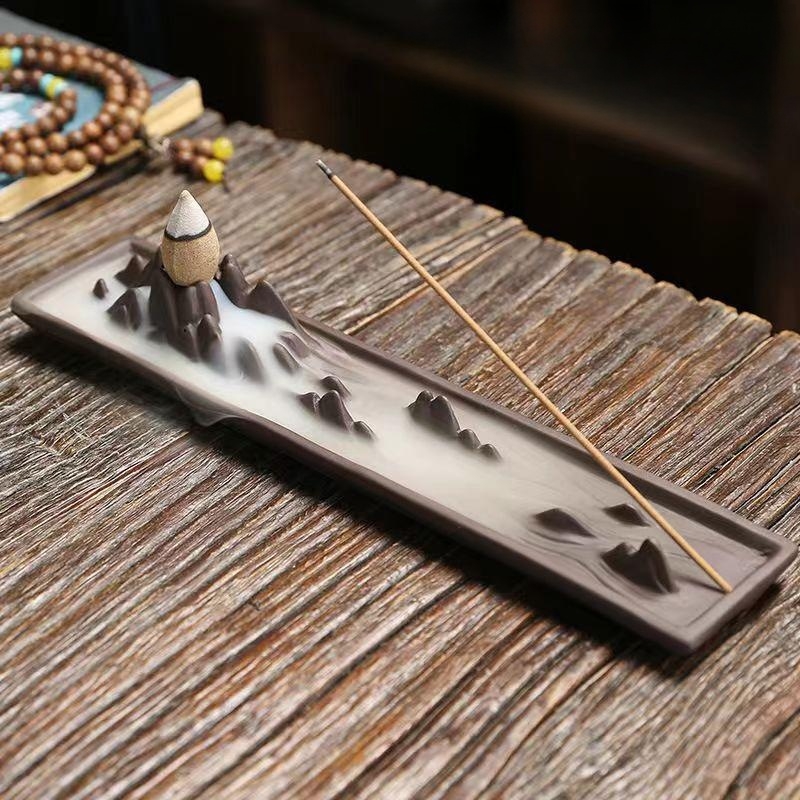
How to Burn Incense Sticks Safely?
Incense sticks, often associated with rituals and spiritual practices, are also popularly used around the world for creating an inviting, calm atmosphere at home or

An incense fountain can be a beautiful addition to any home or office. The soothing sound of trickling water combined with the aromatic scent of incense creates a relaxing environment.
However, incense fountains require some basic care and maintenance to keep them looking and working their best. Follow these tips and tricks to properly care for your incense fountain.

When choosing where to place your incense fountain, there are a few factors to consider:
You’ll want an area with good airflow so the scent can circulate. However, avoid placements directly in front of fans, AC vents, or open windows where the airflow is too strong. The constant blowing can disrupt the delicate ash patterns produced by the fountain.
Pick a spot that allows easy access all around the fountain. You’ll need to be able to reach the pump, lights, incense holders, etc. from all sides. Make sure the area is free of clutter.
Choose a location that could benefit from the tranquil ambiance of the fountain. Many people place them in entryways, living rooms, studies, or bedrooms. Consider the mood you want to create.
Set the fountain on a waterproof surface. Water spills are inevitable when refilling or cleaning. Tile, stone, concrete, and some hardwoods make good foundations. Protect carpets with a mat or stand.
You’ll need an available electrical outlet to plug in the pump and lights. Make sure the cords can reach comfortably. Use extenders if needed, but avoid potential tripping hazards.
Avoid high-traffic areas where people may bump into or disrupt the fountain. Fountains are delicate and spills or breaks can happen if accidentally knocked over.
Consider what decorative accessories or plants you may display around the fountain to enhance its serene ambiance. Make sure these items don’t crowd or block easy fountain access.
In feng shui principles, the best fountain placement is diagonally across from the main entryway. This placement greeted guests with soothing sounds and scents.
The water reservoir will need regular refilling. Use filtered or distilled water only. Tap water can leave behind mineral deposits on the fountain over time.
Consult the manufacturer’s instructions for the proper water level. Mark the fill line with a piece of tape to make it easy to see.
Depending on size, climate, and usage most fountains need water added every 2-4 days. Develop a refilling habit. Add a reminder on your calendar if needed.
Invest in a water level sensor or float valve to automate water refills when the level drops too low. This prevents the pump from running dry.
If refilling manually, pour water slowly and carefully. Turn off the fountain first. Splashing water on electrical components can cause shorts and damage.
The water you add should be near room temperature. Drastic temperature shifts can cause condensation buildup or cracks if the material adjusts too rapidly.
Always use clean, filtered water. Dust, debris, or chemicals added to tap water can clog fountain tubing and mechanics.
Stick to a single type of water each time you refill it. Frequently alternating between tap and filtered water can leave mineral deposits.
Avoid adding oils, scents, bath salts or other additives directly into the fountain water. These can cause foam, clogs, stains, and pump damage.
Regular cleaning keeps your fountain looking pristine and operating properly. Clean every 2-4 weeks based on use.
Always unplug the fountain pump before cleaning. Turn off lights too if applicable. Removing electricity prevents accidental shocks.
Scoop out any leaves or debris. Drain all old water first. A soft cloth can help reach into crevices. Dispose of dirty water down a drain.
Use a soft cloth, sponge, or brush with mild soap and warm water to gently scrub the fountain surfaces inside and out. Avoid harsh cleaners.
Double-check that all soap residue has been rinsed off. Soap can damage pumps or create excess bubbles. Be sure to wipe any spills or drips too.
Allow all fountain surfaces to dry fully before refilling and restarting. Trapped moisture can cause mold or algae. A soft cloth helps dry hard-to-reach spots.
For mineral deposits or water stains, use vinegar and water solution to dissolve the buildup. Never use abrasives that could scratch.
Remove any decorations like rocks or artificial plants. Scrub away any slimy residue or discoloration from sitting in the water before replacing them.
Clean Pump & Tubing
Verify interior pump parts and tubing are sediment-free. Soak in vinegar if needed to dissolve mineral scale or buildup.
Replace filter cartridges at the start of each season for optimal performance. Check monthly and replace it sooner if very dirty.

The fountain pump and filter cartridge are the engines that make everything work. Keep them well-maintained.
Examine any plastic tubing for cracks or leaks. Make sure the tubing is firmly secured. Replace worn parts right away before bigger problems occur.
Remove the filter cartridge every 2-4 weeks when you change the water. Rinse under warm water until it runs clear and looks clean. Let it air dry fully before putting it back.
Every 4 weeks, submerge just the pump fully in white vinegar for 15-20 minutes. This dissolves scale and mineral build up that decreases performance. Rinse thoroughly.
Examine the impeller cover and chamber for debris clogs or damage. Remove anything obstructing the impeller’s rotation.
Verify the pump is circulating water properly without leaks, sputters, or odd noises. Contact the manufacturer if concerned about pump issues.
Ensure the pump sits fully upright at the bottom of the reservoir. Tilting or tipping strains proper functioning. Weigh down if needed.
Check that no water leaks around the pump seal. Tighten or replace if worn. Pump seals prevent water from bypassing the impeller chamber.
Proper lighting adds beauty and ambiance. Follow basic safety steps for best results.
Opt for 12V LED or fiber optic lighting designed specifically for fountains. Avoid standard 120V lights which pose a greater electric shock risk around water.
Lights should fit snugly in position without dangling wires. Loose connections can fall into the water causing shorts or electrocution hazards.
Putting lights on a timer keeps usage consistent and prevents wasting electricity if accidentally left on. Set evening hours to enjoy the calming fountain ambiance.
Feel pendant or floating lights periodically to ensure they aren’t overheating. Lights that get too hot can crack or shatter when doused in water.
Be cautious of fountain sprays directly hitting lightbulbs. Water spray can damage fixtures. Adjust the direction of water flow or lights as needed.
For the safest illumination, use fully submersible underwater lights. Make sure any in-water wires are properly insulated and secured.
Position lights to maximize the fountain’s visual appeal. Up-lighting creates a dramatic effect. Backlighting produces a soothing glow.
Use low-wattage bulbs if enjoying the fountain ambiance in the evenings to prevent glare. Dimmer switches allow adjustable brightness.
The right incense adds lovely aromatherapy to the fountain experience. Take steps to maximize scent diffusion and prevent clogs.
Cone-shaped incense works best in fountain holders. Coil incense and sticks don’t allow proper air circulation resulting in weak aroma diffusion.
Some incense varieties are formulated specifically for use around water. Look for fountain-safe incense that has longer burn times, is extra aromatic, and minimizes ash.
Only submerge the tip of the incense cone in the water, about 1/4 inch deep. Deeper submersion leads to clogged fountain drains.
Arrange multiple incense cones with ample space between them for the best airflow. Crowding cones together can limit fragrance distribution.
Gently shake out old ashes within the incense holder frequently. Excess ash accumulation can block water flow leading to an imbalanced fountain.
Wipe away any ash residue along the fountain basin edges. Accumulated ash is unsightly and can fall back into the water.
Experiment with different incense scents to find your favorites. The aroma variations delivered by sandalwood, floral, cinnamon, or citrus scents keep the experience novel.
Make sure incense smoke isn’t overwhelming the area, blowing directly into your face, or accumulating in 1 spot. Excess smoke can be bothersome.
Hard water minerals leave behind white-scale deposits on fountain surfaces over time. Take proactive measures to minimize buildup.
Frequently wipe down fountain surfaces using a soft damp cloth. This prevents mineral residues from accumulating and drying on surfaces.
Using distilled or purified water eliminates the minerals that lead to scale build-up. Avoid straight tap water which contains more minerals.
Water clarifying additives can bind minerals so they don’t stick on fountain surfaces as readily. Add as directed to help control scale.
If scale deposits do appear, remove them promptly before they bond and build up. Soaking in vinegar usually breaks down early deposits.
For heavy-scale issues, consider installing a whole-house water softener. Softeners remove minerals from the water to inhibit scale altogether.
Make it a habit to wipe down the fountain with a towel after every use. This removes any water droplets before they have a chance to evaporate and leave a mineral residue.
Periodically inspect all fountain surfaces closely for small white accumulations of scale and wipe them away. Addressing buildup early prevents major scale issues.
Remove decorative rocks or ornaments and scrub away any scale deposits before replacing them in the fountain.
Excess moisture can lead to unsightly and harmful mold growth. Take preemptive action to inhibit mold.
Use a dehumidifier to maintain humidity below 50% in the room with the fountain. High humidity encourages mold colonies.
Ensure Good Airflow
Position the fountain away from corners or enclosed spaces lacking airflow. Stagnant air and moisture get trapped, becoming mold breeding grounds.
Avoid placing fountains in sunny areas or directly in front of windows. The heat can accelerate evaporation creating high humidity.
Every few weeks wipe down all fountain surfaces with anti-mold cleaners. This removes any existing spores trying to take hold and grow.
If going on vacation, dry out the fountain fully. Remove all water and let air dry for several days to prevent mold from developing while unattended.
Regularly inspect the pump filter and impeller cover where moisture can accumulate. Discard and replace if you see any fuzzy mold taking root.
For the early stages of mold, scrubbing with diluted bleach solution helps disinfect and inhibit further spreading. Rinse residue away fully.
Inspect where the tubing connects to the pump as moisture often collects here. Disconnect and thoroughly dry out joints if any mold is present.
Stay diligent with regular fountain upkeep for the best results long-term. Mark your calendar for important maintenance tasks.
Mark your calendar to rinse out the pump filter monthly or sooner if fountain use is heavy. Clogged filters strain pump functioning.
Plan to remove and clean the impeller assembly every 6 months. Check for damage or wear and replace if needed.
Every three months use a full vinegar soak for the pump and fountain surfaces to remove scale and mineral buildup inside.
Examine tubing carefully for cracks or leaks annually. Replace any suspect sections right away before failure happens.
Check lighting connections are secure and wiring intact every 12 months. Replace any broken sockets, cracked insulation, or burned-out bulbs.
When storing a fountain for the winter, thoroughly clean, and dry out all components, and store safely indoors.

Even with proper care, occasional issues can still pop up. Try these troubleshooting tips first before calling for service.
Check that the pump is fully submerged, filled with water, and plugged in. Try different outlets in case a loose connection or circuit breaker is tripped.
If the pump rapidly clicks on and off, the water level may be too low. Top off and make sure the pump is fully submerged to operate smoothly.
Tighten all tubing connections. Check for pinhole leaks in the tubing. Clean out the pump impeller covering which can sometimes become clogged forcing water around the seal.
Make sure debris is not blocking the water line or pump intake. Rinse the pump filter. Consider replacing the impeller if the mineral scale has built up over time decreasing flow.
Refresh the water and clean the surfaces. Ensure the pump filter is clean. Add a water-clarifying treatment to help absorb particulates floating around.
Trapped air bubbles making gurgling noises can indicate a water level drop or leak. Refill water, inspect tubing for cracks, and clean the pump impeller covering.
If noticeable vibrations develop, there may be damage to the impeller or debris stuck inside. Open it up to inspect and clear out any obstructions.
For simple bulb replacements, make sure the light wires are disconnected before changing. Always use the wattage specified by the manufacturer.
Thoroughly scrub away mold with bleach cleaner. Increase air circulation and treat all surfaces with anti-mold treatments to prevent recurrence.
When properly cared for, an incense fountain can provide years of enjoyable ambiance and aromatherapy. Place your fountain in an optimal spot, keep it clean, maintain the pump and lights, use quality incense, and troubleshoot problems promptly.
Implementing these incense fountain care tips and tricks will keep your fountain looking and performing beautifully. The tranquil bubbling and sweet-scented steam will promote relaxation and harmony wherever appreciated.
Incorporate the soothing fountain into your daily relaxation regimen and let its Zen sounds transport your mind to a calm, peaceful place.


Incense sticks, often associated with rituals and spiritual practices, are also popularly used around the world for creating an inviting, calm atmosphere at home or

Meditation is an invaluable practice for reducing stress and attaining inner peace. While meditation’s benefits are profound on their own, tools like backflow incense burners

Incense has been an integral part of spiritual practice in The Chan Sect Buddhism for centuries. The burning of incense represents the ephemeral nature of

Incense fountains have become increasingly popular home decor items in recent years. The soothing sound of trickling water combined with the aromatic scent of incense

Incense sticks, often associated with rituals and spiritual practices, are also popularly used around the world for creating an inviting, calm atmosphere at home or

An incense fountain can be a beautiful addition to any home or office. The soothing sound of trickling water combined with the aromatic scent of

Meditation is an invaluable practice for reducing stress and attaining inner peace. While meditation’s benefits are profound on their own, tools like backflow incense burners

Incense has been an integral part of spiritual practice in The Chan Sect Buddhism for centuries. The burning of incense represents the ephemeral nature of
Copyright © 2024 burnwaterfallincense. All Rights Reserved.